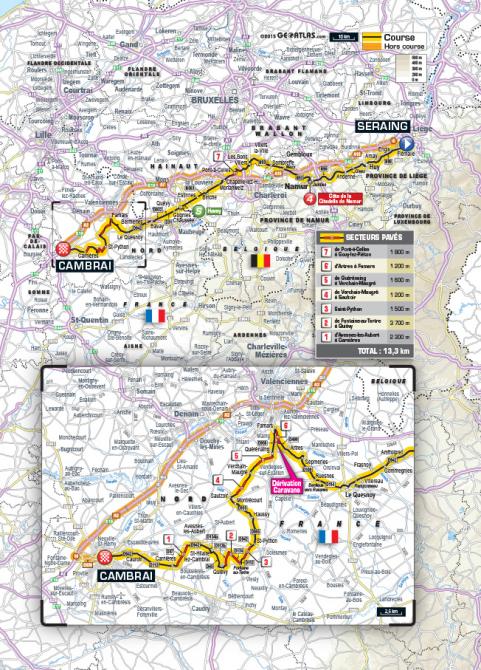Tour de France 2015 Stage 4 preview: Seraing - Cambrai, 223.5 km
The Tour hits Paris-Roubaix cobbles for a second year running. Will they be as pivotal as in 2014?
If the crosswinds of stage two, and the steep finishing climb of stage three haven’t created havoc in the GC, this stage will.
Part three of a trilogy of Classics-flavoured stages sees the Tour return to the cobbles which wrought such devastation in last year’s race. If it rains, as it did in 2014, there will be more action in this single stage than there were in some entire Tours in the early 2000s.
In the modern era, the Tour has tended to leave the cobbles to the spring Classics, but when they were used, they almost invariably ruined the hopes of at least one GC contender. In 1980, Bernard Hinault’s knee started hurting on the cobbled stage and he was forced to pull out a few stages later. The exception, 1989, saw an uneventful traverse of some of the cobbled sectors, which was ironic, considering it is often seen as the most exciting Tour in history. 2004 saw Iban Mayo crash and lose minutes to his main rivals.
All this time, the cobbles were seen as a novelty. However, since 2010, they’ve become a more prominent part of the route design. The 2010 pavé stage was a spectacular, boiling, dusty, hazy war, where Andy Schleck and Alberto Contador put Lance Armstrong to the sword, and Fränk Schleck crashed out. And 2014 was the best of all – a rainy, muddy, gritty throwback to the pre-television era, a stage which changed shape and momentum every time the road turned. Although Chris Froome was seen as the primary victim, he actually crashed out before the race hit the cobbles.
The biggest victim of all was everybody except Vincenzo Nibali, who put in one of the all-time great yellow jersey performances in coming third on the stage. Will he be able to repeat the exploit, even when everybody is expecting it?

Tactical Explainer
Tour stages, especially flat ones, often follow a formula where an early escape of around five riders goes, and is then chased down by the sprinters’ teams. This will be different. Teams with ambitions today, whether it is for the stage win or the GC, simply must put riders up the road. They will be able to help later on in the stage, especially if the peloton splits and other team-mates are caught on the wrong side.
The cobbles will break the field up more effectively than even in Paris-Roubaix. The Tour peloton is a very different animal to the Classics peloton – there are many fewer rouleurs at the Tour, and more climbers, which means gaps will form easily.
Most of the GC favourites last year treated this as a stage on which to minimise time losses, but Vincenzo Nibali exploited that perfectly. As a one-time aspiring Paris-Roubaix rider, he treated this stage as an opportunity. Expect him to do the same this year.

Greg LeMond's view
“I think it’s good to mix it up and throw in some cobblestones every few years. I don’t think it has to be every year, but one of the things that people love about cycling is its history, and the Tour has had cobblestone sections before.
"As much as people say it’s a lottery, this stage is a real test of bike-handling skills. The biggest risk is rain, which will probably mean more punctures. But you can even insure yourself against that to a certain extent with the right tyres. I even think suspension would be helpful for the lightweight riders. The guys who weigh 60 kilos will just bounce around on the cobbles. If I was Quintana, I’d be looking at a bike with three or four centimetres of suspension that you could lock out. I can see why the smaller guys resent having to ride the cobbles, but there’s stuff they can do to help themselves.”
Stats & Facts
- This is the longest stage of the 2015 Tour. The longest stage ever was 482km between Sables d’Olonne and Bayonne, used between 1919 and 1924.
- 221.5km is the shortest distance covered by the Tour’s longest stage in the race’s history.
- The Tour enters France, its third country. The most cosmopolitan Tour was 1992, which visited seven countries in total.
- The Tour last visited the start town, Seraing, in 2012, when Peter Sagan won his first Tour stage.
Schedule
0km Start Seraing 12:00
53km Cat 4 climb Côte de la Citadelle de Namur
101.5km Cobbles sector 7 Pont à Celles 14:29
135km Sprint Havay 15:18
175km Sector 6 Artres 16:15
180.5km Sector 5 Quérénaing 16:20
185.5km Sector 4 Verchain-Maugré 16:29
195.5km Sector 3 St Python 16:44
198km Sector 2 Quiévy 16:48
208.5km Sector 1 Carnières 17:06
218km Finish Cambrai 17:16
The text in this preview first appeared in the July edition of Procycling magazine
The latest race content, interviews, features, reviews and expert buying guides, direct to your inbox!
Latest on Cyclingnews
-
UCl Gravel World Series – Femke Markus holds off Rosa Klöser to win Gravel One Fifty for elite women
Jordan Habets soloes to men's victory at home race in Netherlands -
How to watch the Tour de France 2025: TV, Streaming, official broadcasters
Where to watch the biggest race in the world this July -
Tour de France 2025: All the yellow cards, fines, and penalties
Yellow cards abound on stage 3, Evenepoel hit with fine on stage 4, Milan gets fine after win on stage 8 -
On the eighth day, the Tour de France rested - Why the peloton rode steady on the road to Laval
'It was quite an easy day, I think a lot of guys in the bunch' says Jonas Vingegaard




